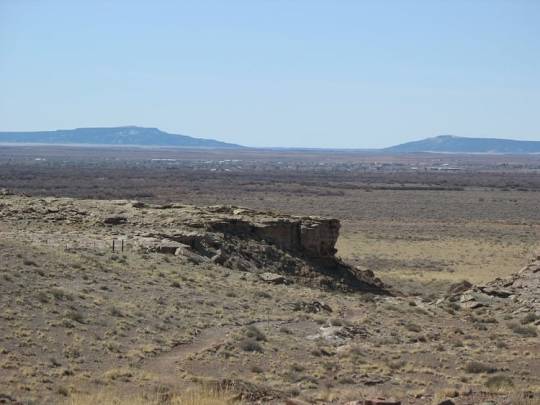#AncestralPuebloanCulture
Photo

Canyon de Chelly
Canyon de Chelly or Canyon de Chelly National Monument is a protected site that contains the remains of 5,000 years of Native American inhabitation. Canyon de Chelly is located in the northeastern portion of the US state of Arizona within the Navajo Nation and not too far from the border with neighboring New Mexico. It is located 472 km (293 miles) northwest of Phoenix, Arizona. Canyon de Chelly is unique in the United States as it preserves the ruins and rock art of indigenous peoples that lived in the region for centuries - the Ancestral Puebloans and the Navajo. Canyon de Chelly has been recognized as a US National Monument since 1931 CE, and it is one of the most visited National Monuments in the United States today.
Geography & Prehistory
The etymology of Canyon de Chelly's name is unusual in the U.S. Southwest as it initially appears to resemble French rather than the more ubiquitous Spanish. "Chelly" is actually derived from the Navajo word tseg, which means "rock canyon" or "in a canyon." Spanish explorers and government officials began to utilize a "Chelly,” “Chegui,” and even "Chelle" in order to try to replicate the Navajo word in the early 1800s CE, which eventually was standardized to “de Chelly” by the middle of the 19th century CE.
Canyon de Chelly lies very close to Chinle, Arizona, and it is located between the Ancestral Puebloan ruins of Betakin and Kiet Siel in the west and the grand structures of Chaco Canyon in New Mexico in the east. Canyon de Chelly, as a National Monument, covers 83,840 acres (339.3 km2; 131.0 sq miles) of land that is currently owned by the Navajo tribe. Spectacularly situated on the Colorado Plateau near the Four Corner's Region, Canyon de Chelly sits at an elevation of over 1829 m (6,000 ft) and bisects the Defiance Plateau in eastern Arizona. The tributaries of the Chinle Creek, which runs through Canyon de Chelly and originates in the Chuska Mountains, have carved the rock and landscape for thousands of years, creating red cliffs that rise up an additional 305 m (1000 ft). The National Monument extends into the canyons of de Chelly, del Muerto, and Monument.
Canyon de Chelly is one of the longest continuously inhabited places anywhere in North America, and archaeologists believe that human settlement in the canyon dates back some 5,000 years. Ancient prehistoric tribes and peoples utilized the canyon while hunting and migrating seasonally, but they did not construct permanent settlements within the canyon. Nonetheless, these prehistoric peoples did leave etchings on stones and on canyon walls throughout what is now Canyon de Chelly. Around c. 200-100 BCE, peoples following a semi-agricultural and sedentary way of life began to inhabit the canyon. (Archaeologists refer to these peoples as "Basketmakers." They are considered the ancestors to the Ancestral Puebloan Peoples.) While they still hunted and gathered like their prehistoric forebears, they also farmed the land where fertile, growing corn, beans, squash, and other small crops. It is also known that they grew cotton for textile production. Yucca and grama grass have grown in the canyon for several millennia, and indigenous people utilized these plants when making baskets, sandals, and various types of mats. Prickly pear cactus (Opuntia cactaceae) and pinyon are also found throughout Canyon de Chelly, the latter of which provided an important source of food for indigenous peoples in autumn and winter. Fish are found in Canyon de Chelly's tributaries, and large and small game frequent the canyon.
Continue reading...
35 notes
·
View notes
Photo

Homolovi
Homolovi or Homolovi State Park (formerly: Homolovi Ruins State Park) is a cluster of archaeological sites that contains the ruins of eight pre-Columbian Ancestral Puebloan (Anasazi) and Hopi pueblos in addition to some 300 other remains and petroglyphs. Homolovi lies within sight of the Little Colorado River in a floodplain, 2 km (4 miles) northeast of Winslow, Arizona in the United States. Archaeologists believe that Ancestral Puebloan peoples and the ancestors of the Hopi tribe once occupied these settlements, which spread out along a 32 km (19 miles) corridor on the Little Colorado River, at different intervals of time from c. 1250-1425 CE. Two pueblos - Homolovi I and Homolovi II - each contained more than 1,000 rooms in ancient times, and 40 ceremonial kivas are scattered throughout the park. The Homolovi ruins are unique in the ancient Southwest as they have helped archaeologists better understand the cultural transitions and social changes that occurred in the region during the 13th through 14th centuries CE. Four of the sites at Homolovi are listed on the U.S. National Register of Historic Places, and the park is currently managed by the Arizona State Park system.
Learn more about Homolovi
57 notes
·
View notes